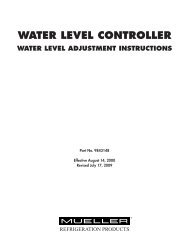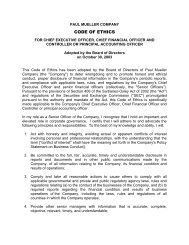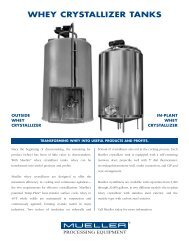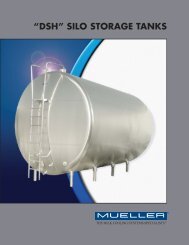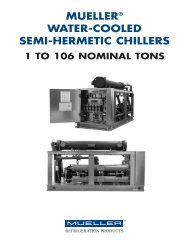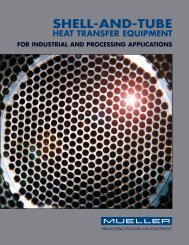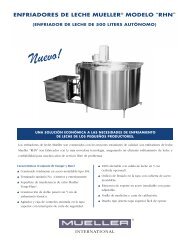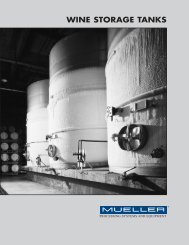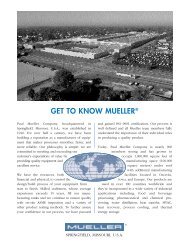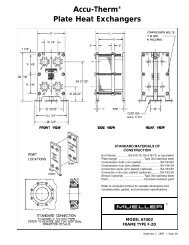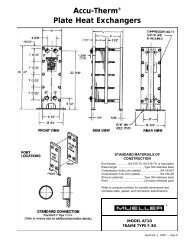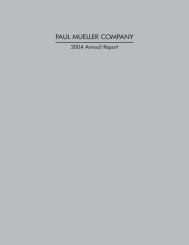ALL ABOUT TEMP-PLATE® - Paul Mueller Company
ALL ABOUT TEMP-PLATE® - Paul Mueller Company
ALL ABOUT TEMP-PLATE® - Paul Mueller Company
You also want an ePaper? Increase the reach of your titles
YUMPU automatically turns print PDFs into web optimized ePapers that Google loves.
Temp-Plate — Repairs<br />
The following repair techniques are recommended<br />
whenever defects arise due to accidental damage, such as<br />
leaks, etc.:<br />
1. PRIOR TO REPAIR:<br />
Remove any contamination that might be present in<br />
the defect area. There are various solvents and/or<br />
mechanical means (grinding, brushings, etc.) that are<br />
effective in removing this foreign matter. After initial<br />
area cleaning, the defect itself needs to be removed to<br />
assure that good sound metal is present. Once good<br />
metal is reached, proceed with the weld repairs.<br />
2. WELD REPAIR INFORMATION:<br />
A. Temp-Plate, Stainless Steel — Normally one of<br />
the conventional welding processes is used for<br />
repairing defects.<br />
(1) For Type 304 stainless, use one of the<br />
following:<br />
a. Manual Shielded Metal Arc Welding<br />
(SMAW, stick): Use either 3 /32" or 1 /8"<br />
diameter E308-16 (AC-DC) electrode per<br />
AWS A5.4 specifications.<br />
b. Semi-Automatic Gas Metal Arc Welding<br />
(GMAW, short arc, MIG): Use .035"<br />
diameter or .045" ER308-type filler wire<br />
meeting AWS A5.9 specifications.<br />
c. Manual Gas Tungsten Arc Welding<br />
(GTAW - TIG - heliarc): Use 1 /16" or 3 /32"<br />
diameter ER308 bare filler rod meeting<br />
AWS 5.9 specifications.<br />
(2) For Type 316 stainless, use one of the<br />
following:<br />
a. SMAW Process: Use 3 /32" or 1 /8" diameter<br />
ER316-16 (AC-DC) electrodes meeting<br />
AWS A5.4 specifications.<br />
CLEANING, MAINTENANCE, AND REPAIRS<br />
b. GMAW Process: Use .035" or .045<br />
diameter ER316-type filler wire meeting<br />
AWS A5.9.<br />
c. GTAW Process: use 1 /16" or 3 /32"<br />
diameter ER316 bare filler rod meeting<br />
AWS A5.9 specifications.<br />
(3) For low-carbon grades stainless steel base<br />
materials, use L-grade-type filler metal to<br />
match the corrosion resistant characteristics.<br />
(4) For austenitic stainless steel, the weld deposit<br />
must be cooled to below 800°F within one<br />
minute after welding in order to keep the<br />
carbide precipitation to a minimum.<br />
B . Temp-Plate, Carbon Steel — The conventional<br />
method normally selected is the Shielded Metal<br />
Arc Welding process (SMAW - stick). The allposition<br />
electrodes E60XX or E70XX series, AWS<br />
A5.1-type electrodes are generally recommended.<br />
A typical selection would be an 1 /8" diameter, AC<br />
or DC reverse polarity electrode.<br />
C. Temp-Plate, Other Alloy Materials — Contact<br />
<strong>Paul</strong> <strong>Mueller</strong> <strong>Company</strong> personnel on such repairs<br />
or with the original manufacturer of that grade<br />
of material.<br />
3. AFTER WELD REPAIR IS COMPLETED:<br />
A general cleaning, either mechanical or with<br />
chemical solvents, should be done to remove any<br />
contaminants remaining. <strong>Paul</strong> <strong>Mueller</strong> <strong>Company</strong>’s<br />
pickling paste is recommended for removing weld<br />
surface oxides and restoring corrosion resistance on<br />
stainless steel Temp-Plate.<br />
www.hxrx.com 29



